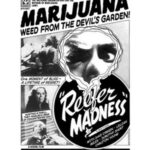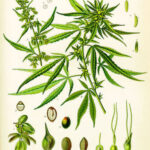Estes
Contemporary Health Issues
Pam Bass, Instructor
“What Happens While ‘Wet'”
Just below the first ranking alcohol, and second ranking cigarettes, marijuana comes in at the fourth next highest indulgence for full-time college students and other people equally. Six point three percent of students versus seven point one other individuals are reported to consume hallucinogens. The fifth of the largest consumptions are: any other illicit drugs besides cannabis. We should start to question ourselves: is this figure inclusive of embalming fluid? This substance is perfectly legal, but the latest trend of combining Mary Jane, phencyclidine, and formaldehyde may push law makers and morticians alike to push for tighter control of the latter.
The use of marijuana dipped in PCP-laced embalming fluid was reported firstly around the 70’s in and around Trenton, New Jersey. More recently, abuse of the substance was reported in Hartford and other surrounding CT cities. In the Connecticut area the laced marijuana is known as ‘illy’. Other areas such as Chicago, IL refer to the mixture as ‘happy sticks’, which are hollowed out cigar blunts filled with marijuana, PCP and dipped in embalming fluid. The composition is referred to in Cleveland as: ‘sherm’, ‘wet’, or ‘sheba’. Kansas City, MO famed nomenclatures: ‘dank’, and ‘therm. Regions like New Orleans, Washington D.C. and Houston, TX have unique names like: ‘clickums’, ‘loveboat’, and ‘wack’ (chronologically correlative to the city listings).
The epidemic seems to have peaked in 1993 or 1994. Use by adolescents became so problematic that a Hispanic gang, the Latin Kings, asked the State Department of Public Health to intervene[1]. The National Institute on Drug Abuses Community Epidemiology Work Group from Philadelphia and Washington, D.C. indicated that the increased use of PCP may be associated with the growing utilization of marijuana cigarettes, and marijuana cigars progressively laced with PCP. During the same time, Los Angeles recorded finding PCP-sprayed tobacco, parsley, or marijuana, and Chicago reported the use of ‘sherm (or happy) sticks. In New York City, PCP was sprinkled on mint or parsley leaves and sold by the bag, while dealers allowed individuals to dip a cigarette into a small container of embalming fluid for approximately $20 per dip. Whether the New York embalming fluid itself contained PCP is still undocumented.
Use of the PCP, embalming fluid-laced, marijuana blend has also made its way into Texas. In the city of Houston, the use of marijuana cigarettes laced with embalming fluid appeared in the news in 1992. Two years later in a survey of youth entering Texas Youth Commission facilities, 3.8 % of them reported ever using ‘wack’ or ‘fry’, while 2.3 % of participants reported using the substance within their last month of freedom[2].
The use of ‘fry’ or ‘wet’ has not yet become so widespread that it warrants a broadly based campaign as in Connecticut, but it is clear that education about this substance is necessary so that the general public is informed of this dangerous additive in some marijuana cigarettes or blunts. Marijuana smokers need to know that adulterated marijuana may contain other, hazardous substances that can put them at extreme, immediate risk of adverse effects. PCP has an underground street name of ‘water’, or ’embalming fluid’ because it can be presented in bitter-tasting, clear liquid form that is consumed orally, injected, sniffed, or smoked on tobacco or marijuana products.
Phencyclidine is also available in a white crystal-like power form, a pill or capsule and may be called ‘angel dust’, ‘crystal’, or ‘horse tranquilizer’. The drug intensifies the effects of other depressants, and can cause severe hallucinations, impaired motor coordination, extreme anxiety, depression, disorientation and paranoia. Not to mention: aggressive behavior and violence, seizures, and respiratory arrest; even comas and/or death may result from over-intoxication.
In May of 2003, for the first time I was exposed to the consuming of ‘wet’ via Ricki Lake, whom aired a special exploring the swelling trend of ‘getting wet’. There was segment about a young man who committed the major offense of murder under the influence, but was unable to recall the events of the night in question. Amnesia is a factor that influenced the withdrawal of PCP from the legal market as an anesthetic. Patients often times experienced delirium and agitation, and later the drug was moved to tranquilize animals before being discontinued.
People indulging in the recreational psychoactive (wet) may become limp and catatonic within their upper extremities, there is a period where paranoia soars and hallucinations are intensified. In a personal interview of an observer watching someone using wet, within the first five minutes there seemed to be no change. However, as time progressed it seems as if the person slips into a “semi-coma”[3]. The subjects on Ricki Lake refer to the catatonic state as being ‘stuck’. Essentially trapped in time; unable to move at will.
In Houston, increased forgetfulness was cited following days of reported group sex (while high on ‘wet’) and trading sex for ‘fry sticks’. This short-term memory loss was described as more extensive than after smoking marijuana. The users also relayed vomiting, depression or sadness, and facial or bodily edema in the reports. The increase in the use of fry and in the incidence of sexual intercourse in relation to the substance may assist in the amplified transmission of STDs, (including HIV) among young people throughout this decade.
The poison control centers, at first, were unsure whether to catalog the intoxications under marijuana or PCP, and it was in Galveston and Connecticut that the wet-related data collections began in 1993. In 1985, Ivan Spector published a series of cases in which five patients smoked ‘wet’. The notations made by him regarding their conditions were: difficulty producing speech, sweating, increased salivation, and the inability to entertain environmental stimuli.
A report appearing three years later mentioned confusion, irritation, upper body weakness, and depressed reflexes as outcomes of a patient smoking two cigarettes dipped in formaldehyde. In said case, it took 17 days for the person to return to a homeostasis stage and no allusion to the use of phencyclidine was indicated. Contrary to the omission, the patient suffered nystagmus or rapid involuntary movement of the eyeball(s), which highly suggests PCP inebriation.
The irony and blatant harm lies in the suggestion that Spector made about the post intake behavior reactions; he proposes that when patients endured acute anoxic encephalopathy or damage to the brain due to lack of oxygen, it was due to altering the THC molecule by the induction of formaldehyde. Formaldehyde intoxication proper led to affecting lung parenchyma (or functioning). However, when five samples of ‘illy’ or ‘water water’ were examined, the concluding analyses yielded no marijuana at all. The samples were consistent with mint leaves soaked in embalming fluid and PCP. One case was neither mint nor marijuana, but cut up duct tape; all of the samples had findings of PCP, but no weed. Still, more oxymoronic are: six patients who had visited the E.R. and admitted to smoking ‘wet’, but their urinalyses revealed negative flags of phencyclidine.
Despite the toxicology adversities, polydrug use is on the rise. The terms for embalming fluid-saturated marijuana are actually alternate names for PCP in different corners of the States. The disparity doesn’t seem to lie within the actual mixing of the substances, but the misconceptions of what the combined substances really are. Recovery patients in an Angleton, TX rehab center were said to have permanent mental deficiencies related to attending ‘fry houses’, ‘dank houses’ or ‘getting wet’. There were repeated descriptions of memory dysfunction, decreased spontaneous speech, lethargy and two other cases accounted for persistent dysmnesia, or poor or impaired memory. Several observations of individuals regaining normalcy from ‘wet’ are symptomatic of medium to high PCP ingestion. The ending result leans heavily upon the dosage consumed.
The long-term effects of smoking ‘fry’ or ‘wet’ are not pretty. Participants recalled seeing long-term smokers who muttered to themselves as they walked around in bizarre fashions. Such impaired individuals also ceased their personal grooming habits, and were dirty and disheveled. So it is appropriate to corroborate the contribution of using ‘wet’ may later lead to suffering schizophrenia. Five adolescents in one study conveyed that smoking fry causes brain damage; two knew friends who were in mental health/mental retardation facilities because they had overdosed on use of the combination.
Two additional long-term effects of the embalming fluid are: accumulation in the spinal cord, which in turn, causes the back to break down. It is also thought to halt the maturation process. Other effects listed by the state of Connecticut include: high fever, heart attacks, high blood pressure, damage to the kidneys, destruction of muscle tissue, brain damage, coma, convulsions, coughing, pneumonia, anorexia, and death. Exposure to embalming fluid, alone, includes: bronchitis, body tissue ruin, brain damage, lung damage, impaired coordination, and inflammation and sores in the throat, nose, and esophagus[4].
While it is inconclusive to gather total data of people consuming ‘fry’ or supposed marijuana dipped in formaldehyde, it is clear that the use of PCP within the concoctions needs to be investigated. For those people like the young man on Ricki Lake serving twenty-five years for a crime executed at his hand, yet unbeknownst to his recollection. Moreover, he was unaware that the marijuana cigarette he took a drag off of prior to performing the criminal act of murder was, indeed, ‘wet’. The people that are paralyzed by ‘water water’ are driven by auditory hallucinations to do things that their memory fails to record afterward.
In one case a young Connecticut man slit his wrists and drank floor stripper, under the ‘illy’ psychosis episode he wanted to kill himself before “they got him”; a precise display of acute paranoia and acoustic hallucination. A homosexual male ‘hydro’ smoker from New York City heard a distant male voice call his name under the influence. There was a narrative detailing memory disturbances, especially forgetting what was being said while speaking, and also an admittance of unprotected anal sex during the time he was high. He reported no memory of the consummation, and it was only through friends that was he informed. He, too, was unsure whether the marijuana included PCP.
A potential long-term effect of marijuana is, in fact, impaired memory function but the occurrences exhibited in aforementioned case studies suggest the public really is ignorant to the actuality of their purchase of ‘wet’ weed, or ‘fry’ cigarettes. Because it is obviously a common recreation in areas such as TX and CT there has been a surge in health department reports and website dedications. Nevertheless, there needs to be a national focus on the re-emergence of phencyclidine. The hazard of over-consumption needs to be addressed, and America needs to be real and surcease cannabis bashing. It is perceived that addiction to ‘fry’ or ‘wet’ can occur as early as initial consumption, and the majority of participants indicated that their second time of ‘getting wet’ occurred either the same day as their initial use or on the next day. Marijuana is drug that has been proven to cure nausea and vomiting in chemotherapy patients, promotes appetite in AIDS patients, and reduces the pain that attacks glaucoma suffers and it does not need to be re-evaluated. The synthetic compound that was taken off the legal market for possible results of death and psychotic induced brain damage is the one that needs to be tackled. PCP is the silent destroying culprit of death-defying ‘wet’ not sativa. It’s about time that the government whet the public’s palate with the information needed to help guard our children against the showering, expanding effect of getting ‘fried.
[1] (Pestana, 1997)
[2] (Fredlund, Farabee, Blair, & Wallisch, 1995, p. 22)
[3] Personal communication with Marvin
[4] (Bardana & Montanaro, 1991; State of Connecticut, 1994a; Wessels, 1997)





